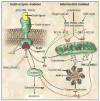Cell death
- PMID: 19828534
- PMCID: PMC3760419
- DOI: 10.1056/NEJMra0901217
Cell death
Figures





References
Publication types
MeSH terms
Grants and funding
LinkOut - more resources
Full Text Sources
Other Literature Sources
